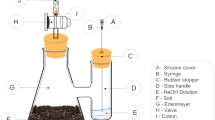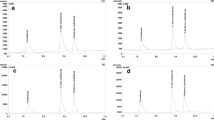Abstract
The persistence and metabolism of imidacloprid in soil under sugarcane were studied following application of imidacloprid at 20 and 80 g active ingredient (a.i.) ha−1. Soil samples were collected at different time intervals (7, 15, 30, 45, 60 and 90 days after application), and the residues of imidacloprid and its metabolites (6-chloronicotinic acid, nitrosimine, imidacloprid-NTG, olefin, urea and 5-hydroxy) were quantified by high-performance liquid chromatography. In soil, the total imidacloprid residues were mainly constituted by the parent compound followed by 6-chloronicotinic acid, nitrosimine and imidacloprid-NTG metabolites. Maximum residues of imidacloprid and its metabolites were 4.29 and 7.81 mg kg−1 in soil samples collected 7 days after the application of imidacloprid at 20 and 80 g a.i. ha−1, respectively. At both doses, these residues declined to below the detectable limit in soil after 90 days of application. Olefin, urea and 5-hydroxy metabolites were not detected in soil. Dissipation of total imidacloprid residues did not follow the first-order kinetics with a coefficient of determination value of 0.883 and 0.838 for the recommended dose and four times the recommended dose, respectively. The half-life (T 1/2) value of total imidacloprid was observed to be 10.64 and 10.10 days for the recommended dose and four times the recommended dose, respectively.


Similar content being viewed by others
References
Anonymous (2011). Package of practices for Kharif crops. pp 89–108, Punjab Agricultural University, Ludhiana.
Bacey, J. (2000). Environmental fate of imidacloprid http://www.cdpr.ca.gov/docs/emon/pubs/fatememo/imid.pdf. Accessed Dec 2011.
Dharumarajan, S., Dikshit, A. K., & Singh, S. B. (2009). Persistence of combination-mix (β-cyfluthrin + imidacloprid) on tomato (Lycopersicon esculentum). Pesticide Research Journal, 21, 83–85.
Dikshit, A. K., Singh, V. S., Sharma, R., Palta, R. K., & Kumar, R. (2005). Residue studies and risk assessment of imidacloprid from 70 WG formulation on rice and cotton crops. Pestology, 29, 24–29.
Donnarumma, L., Pulcini, P., Pochi, D., Rosati, S., Lusco, L., & Conte, E. (2011). Preliminary study on persistence in soil and residues in maize of imidacloprid. Journal of Environmental Science and Health. Part. B, 46, 469–472.
El Hamady, S. E., Kubiak, R., & Derbalah, A. S. (2008). Fate of imidacloprid in soil and plant after application to cotton seeds. Chemosphere, 71, 2173–2179.
Gopal, M., Mukherjee, I., & Chander, S. (2002). Behaviour of beta-cyfluthrin and imidacloprid in mustard crop: alternative insecticide for aphid control. Bulletin Environmental Contamination and Toxicology, 68, 400–405.
Gunther, F. A., & Blinn, R. C. (1955). Analysis of insecticides and acaricides. New York: Interscience.
Hoskins, W. M. (1961). Mathematical treatment of loss of pesticide residues. FAO Plant Protection Bulletin, 9, 163–168.
Khan, S. U. (1980). Occurrence and persistence of pesticide residues in soil. In: Pesticides in the soil environment. Amsterdam: Elsevier. p. 240.
Krohn, J. & Hellpointner, E. (2002). Environmental fate of imidacloprid. Pflanzenschutz Nachrichten Bayer 55. Special edition. www.bayercropscience.com/bayer/cropscience/cscmsnsf/id/studies/$file/Gaucho_Studien_IV_2_engl.pdf . Accessed Dec 2011.
Mandal, K., Chahil, G. S., Sahoo, S. K., Battu, R. S., & Singh, B. (2010). Dissipation kinetics of β-cyfluthrin and imidacloprid in brinjal and soil under subtropical conditions of Punjab, India. Bulletin Environmental Contamination and Toxicology, 84, 225–229.
Nauen, R., Tietjen, K., Wagner, K., & Elbert, A. (1998). Efficacy of plant metabolites of imidacloprid against Myzus persicae and Aphis gossypii (Homoptera: Aphididae). Pesticide Science, 52, 53–57.
Pimentel, D. (1995). Amounts of pesticides reaching target pests: environmental impacts and ethics. Journal of Agricultural and Environmental Ethics, 8, 17–29.
Romeh, A. A., Mekky, T. M., Ramadan, R. A., & Hendawi, M. Y. (2009). Dissipation of profenofos, imidacloprid and penconazole in tomato fruits and products. Bulletin Environmental Contamination and Toxicology, 83, 812–817.
Rouchaud, J., Gustin, F., & Wauters, A. (1994). Soil organic matter ageing and its effect on insecticide imidacloprid soil biodegradation in sugar beet crop. Toxicological and Environmental Chemistry, 45, 149–155.
Rouchaud, J., Gustin, F., & Wauters, A. (1996). Imidacloprid insecticide soil metabolism in sugar beet field crops. Bulletin Environmental Contamination and Toxicology, 56, 29–36.
Sarkar, M., Roy, S., Kole, R., & Chowdhury, A. (2001). Persistence and metabolism of imidacloprid in different soils of West Bengal. Pest Management Science, 57, 598–602.
Scholz, K. & Spiteller, M. (1992). Influence of groundcover on the degradation of 14C-imidacloprid in soil. Proceedings of the Brighton crop protection conference—pests and diseases. pp 883–888.
Sharma, S., & Singh, B. (2012). Efficacy of imidacloprid against sugarcane shoot borer. Proceedings of the international conference on sustainable agriculture for food and livelihood security (39 (spl issue)th ed., pp. 1067–1068). Ludhiana, India: Crop improvement.
Sharma, S. & Singh B. (2013). Persistence of imidacloprid and its major metabolites in sugarcane leaves and juice following its soil application. International Journal of Environmental Analytical Chemistry, in press.
Skidmore, M. W., & Ambrus, A. (2004). Pesticide metabolism in crops and livestock. In D. Hamilton & S. Crossley (Eds.), Pesticide residues in food and drinking water: human exposure and risks (pp. 63–120). New York: Wiley.
Sun, H., Xu, J., Yang, S., Liu, G., & Dai, S. (2004). Plant uptake of aldicarb from contaminated soil and its enhanced degradation in the rhizosphere. Chemosphere, 54, 569–574.
Van Eerd, L. L., Hoagland, R. E., Zablotowicz, R. M., & Hall, J. C. (2003). Pesticide metabolism in plants and microorganisms. Weed Science, 51, 472–495.
Wu, S. G., Wu, L. Q., Xu, H. Z., Xue, P., Wu, C. X., Chen, L. P., Zhang, H., & Wang, Q. (2004). Study on residue of imidacloprid in rice and field environment. Acta agriculturae Zhejiangensis, 16, 274–278.
Zacharia, J. T., Kishimba, M. A., & Masahiko, H. (2010). Biota uptake of pesticides by selected plant species; the case study of Kilombero sugarcane plantations in Morogoro Region, Tanzania. Pesticide Biochemistry and Physiology, 97, 71–75.
Acknowledgments
The authors are thankful to the Professor and Head of the Department of Entomology, PAU, Ludhiana, for providing the necessary research facilities.
Author information
Authors and Affiliations
Corresponding author
Rights and permissions
About this article
Cite this article
Sharma, S., Singh, B. Persistence behaviour of imidacloprid and its metabolites in soil under sugarcane. Environ Monit Assess 186, 2281–2288 (2014). https://doi.org/10.1007/s10661-013-3536-1
Received:
Accepted:
Published:
Issue Date:
DOI: https://doi.org/10.1007/s10661-013-3536-1




